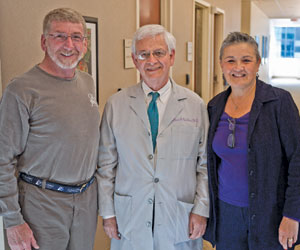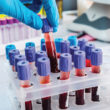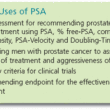How It Is Used and What It Means

Negligible PSA
PSA after removal of the prostate should be negligible because no prostate cells should remain.
Depending somewhat on how high the PSA level was before surgery, the PSA should be less than 0.1 in the first follow-up visit after surgery and in all subsequent follow-up visits.
Follow-up visits are usually scheduled within the first 2 months after surgery.
PSA readings above negligible mean that prostate cells are still present and are creating prostate specific antigen.
Salvage radiotherapy is recommended for a rising PSA after prostatectomy. This radiotherapy should be given before the PSA level rises above 1.0 ng/mL.
No Reason To Worry Needlessly
Patients need to remember their math and decimal points in interpreting their follow-up PSAs. No reason to worry needlessly.
For practical purposes, it is difficult to detect PSA when levels are less than 0.1 ng/mL. Therefore, we consider any PSA value less than 0.1 as being negligible. A value of 0.1ng/mL would be considered essentially zero. PSA above 0.1 is usually an indication of cancer recurrence, and treatments for recurrence should begin before the PSA reaches 1.0ng/mL.
We get questions from worried patients who have a follow-up PSA of .04. That is considered negligible. If it were 0.4, then that would not be considered negligible but even then, before any treatment decision, the test should be taken again to ensure that the result is not a laboratory error.
Radiotherapy and When
Salvage radiotherapy is intended to destroy any remaining prostate cells in the bed of the tissues that held the prostate.
Radiotherapy at this stage is curative in intent with the purpose being that all potential cancer cells will be destroyed before they can spread to other parts of the body.
The higher the PSA reading at time of follow-up treatment, the less likely that radiotherapy will be as effective as if done earlier.
If radiotherapy destroys the remaining prostate cells, PSA tests will again be negligible.
If PSA continues to rise after salvage radiotherapy, then additional treatment, most likely hormonal therapy, will be recommended when PSA is 4.0 ng/mL.
Rate of Rise
In some instances, the rate of rise is important. If the PSA begins to rise many years after surgery and rises very slowly, immediate further treatment might not be necessary.
However, if it rises persistently, treatment should be initiated before the PSA gets higher than 1.0 – if the follow-up treatment is to be salvage radiation therapy.
Follow-up PSA testing after removal of the prostate is important, and I recommend my patients get a PSA test every six months for fifteen years.
That said, in the category of men who have a prostate cancer removed that is very small and totally contained within the prostate and all the margins are clear and it has not spread to any lymph nodes, life expectancy is virtually equal to that of the normal population who have never had prostate cancer.
That said, in the category of men who have a prostate cancer removed that is very small and totally contained within the prostate and all the margins are clear and it has not spread to any lymph nodes, life expectancy is virtually equal to that of the normal population who have never had prostate cancer.


PSA Interpretation for Treatments Other Than Prostatectomy
For those who have had treatment for prostate cancer other than removal (such as seed implants, radiation, cryoablation, HIFU, etc), follow-up PSA readings have a different meaning.
Let me say that my recommendation for treatment of prostate cancer in otherwise healthy men with at least a 10-year life expectancy is to remove the prostate with the intent of removing all the cancer and achieving a complete cure.
With other treatments, PSA is still being produced, because the prostate is still there. Values usually do not go to negligible, and rising PSA is an indication for concern.
When the prostate is still present, cancers can develop in other places in the gland but inflammation (prostatitis) can develop as well. Rising PSA must be watched carefully and regularly.
Any change in PSA for patients who have not had their prostate removed should be taken seriously, and a urologist specializing in prostate cancer should diagnose the cause for the change quickly.
Any change in PSA for patients who have not had their prostate removed should be taken seriously, and a urologist specializing in prostate cancer should diagnose the cause for the change quickly.
Again, let me say that I regard active surveillance as an option after a positive biopsy is indicated only in special situations related to tumor features, age and other medical conditions.
I usually recommend removal of the prostate to achieve a lifetime cure in patients with a long life expectancy and tumor and/or PSA features that suggest a progressing tumor.
In such patients, the earlier the removal of the cancer, the better the chances of achieving a lifetime cure.
But for those men who have chosen active surveillance, a rising PSA may be an indication of a change that would mandate active treatment, and follow-up biopsies are necessary to determine whether more extensive or higher Gleason grade cancer is present.
There is no debate that PSA testing is a useful, necessary, and life-saving test for evaluating the effectiveness of prostate cancer treatment.











